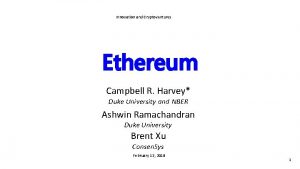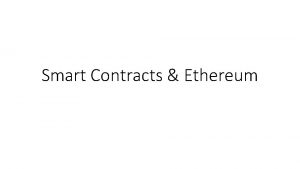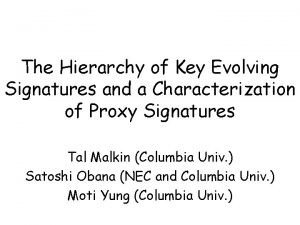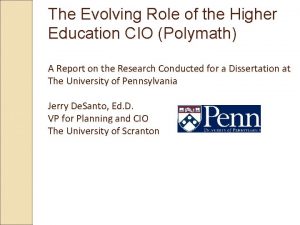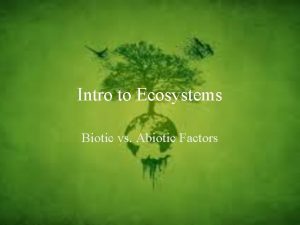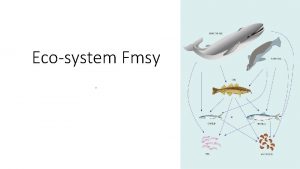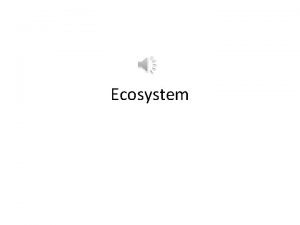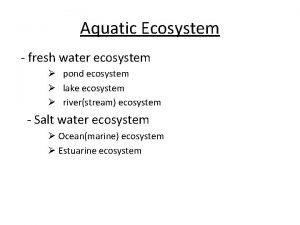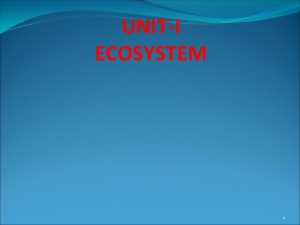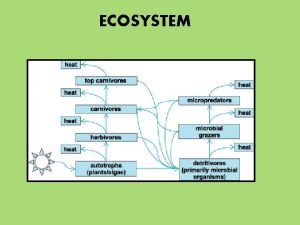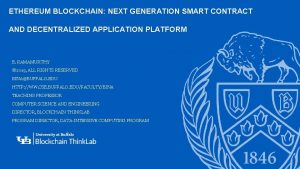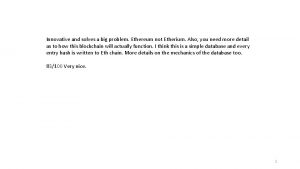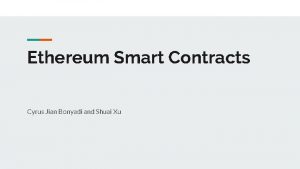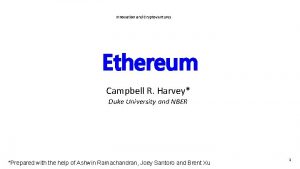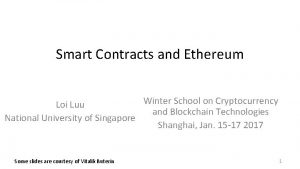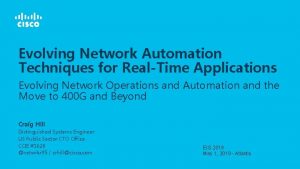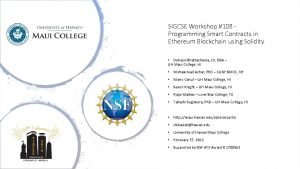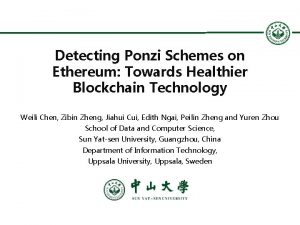The evolving Ethereum ecosystem L 1 and L












![Current Ethereum 1. 0 ecosystem Other major Dapps • Aragon [Aragon: ANT] • Decentralized Current Ethereum 1. 0 ecosystem Other major Dapps • Aragon [Aragon: ANT] • Decentralized](https://slidetodoc.com/presentation_image_h2/3e5e72ad3a33729e6d784a1130196f98/image-13.jpg)









































- Slides: 54

The evolving Ethereum ecosystem L 1 and L 2 improvements to scalability and privacy and other trends 10 th July 2019 Roberto Infante

My book: Building Ethereum Dapps London Ethereum Meetup Manning discount code: mtpeldn 19 https: //www. manning. com/books/building-ethereum-dapps (valid also for any Manning book) 2

The evolving Ethereum ecosystem • Review current ETH 1. 0’s ecosystem • What’s wrong with ETH 1. 0? • L 1 and L 2 solutions to ETH 1. 0’s issues • Main ecosystem’s trends 3

The evolving Ethereum ecosystem • Review current ETH 1. 0’s ecosystem • What’s wrong with ETH 1. 0? • L 1 and L 2 solutions to ETH 1. 0’s issues • Main ecosystem’s trends 4

Current Ethereum 1. 0 ecosystem you might know • • • Ethereum Level 1 (the core protocol, clients) Smart contract EVM languages: Solidity Smart contract Libraries: openzeppelin Web 3 libraries: web 3. js Dev tools: truffle Security tooling Additional P 2 P networks (content, messaging) Oracles: Provable Things (formerly Oraclize) ENS Major Dapps: Decentralized Finance (De. Fi) Other major Dapps: Aragon, Augur 5

Current Ethereum 1. 0 ecosystem Ethereum Level 1 (the core protocol, clients) • Clients: geth (Go, 50%) • parity (Rust, 40%) • pantheon (java) + Nethermind (. NET) + pyethreum (good for prototyping new implementations, like Casper FFG) • • Managed clients: Infura: main player (almost only one until 2018) • Dappnode, VIP mode, Denode: cheaper infra for personal / Dev use • 6

Current Ethereum 1. 0 ecosystem Core Dev tools • Smart contract EVM languages: Solidity, Vyper • Smart contract libraries (mainly Solidity): • open. Zeppelin • Web 3 libraries: Java. Script: Web 3. js and ethers. js • Java: web 3. j • 7

Current Ethereum 1. 0 ecosystem Additional Dev tools • General Dev tools • Remix, Truffle, Embark, Ether. Lime • Security tooling: Trail of bits (static analysers, fuzzing tools, etc) • Securify: automated SC scanner • Myth. X (formerly Mythril): security analysis • 8

Current Ethereum 1. 0 ecosystem Additional P 2 P networks • Decentralized content networks: • IPFS • Swarm (Ethereum friendly) • Decentralized messaging • Whisper (Ethereum friendly) 9

Current Ethereum 1. 0 ecosystem Oracles frameworks • Provable Things (formerly Oraclize): centralized oracle framework 10

Current Ethereum 1. 0 ecosystem Ethereum Name Service (ENS) 11

Current Ethereum 1. 0 ecosystem Major Dapps: Decentralized Finance (De. Fi) • Maker DAO [Maker: MKR, https: //makerdao. com/en/]: Protocol initially for creating DAO, but later focused on facilitating decentralized coins, especially stable coins, decentralized lending • Example of stable coin: Dai [Dai: DAI] • • Other stable coins on Ethereum: True. USD, Paxos, Gemini Dollar, USD coin s. USD => total market cap: $750 M, daily trading $200 M • Move from ICO to STO and emphasis on regulated Security tokens • 0 X protocol [0 x: ZRX, https: //0 x. org/] Framework for building easily decentralized exchanges (DEX) for ERC 20 and ERC 721 assets on Ethereum blockchain • Allows aggregating coin and token liquidity • Allows swapping ERC 20 and ERC 721 (non fungible) in a single atomic operation • Trading directly from wallet (keep custody, don’t pay fees): Radar relay https: //radarrelay. com/, Paradex: • https: //paradex. io/: • Hydro protocol [Hydro: HYDRO, Hydro Protocol: HOT, https: //hydroprotocol. io/] • Framework for building easily decentralized exchanges (DEX) 12
![Current Ethereum 1 0 ecosystem Other major Dapps Aragon Aragon ANT Decentralized Current Ethereum 1. 0 ecosystem Other major Dapps • Aragon [Aragon: ANT] • Decentralized](https://slidetodoc.com/presentation_image_h2/3e5e72ad3a33729e6d784a1130196f98/image-13.jpg)
Current Ethereum 1. 0 ecosystem Other major Dapps • Aragon [Aragon: ANT] • Decentralized Autonomous Organization DAO frameworks • Augur [Augur: REP] • Prediction market 13

Current Ethereum 1. 0 ecosystem Core ecosystem 14

Current Ethereum 1. 0 ecosystem Extended ecosystem 15

The evolving Ethereum ecosystem • Review current ETH 1. 0’s ecosystem • What’s wrong with ETH 1. 0? • L 1 and L 2 solutions to ETH 1. 0’s issues • Main ecosystem’s trends 16

What’s wrong with Ethereum 1. 0 The outstanding issues after Constantinople fork • Various improvements to L 1 technology (core Ethereum protocol) however… • Still a big elephant in the room: Ethereum still seen as not fit for purpose for commercial applications Cannot match expected scalability (of competing traditional centralised systems) • Does not provide privacy • 17

What’s wrong with Ethereum 1. 0 Capacity utilization: near saturation since Oct 2017 18

What’s wrong with Ethereum 1. 0 Near saturation… with less than 1 M Tx per day! 19

What’s wrong with Ethereum 1. 0 More on utilisation • More used Dapps: • Dai stable coin by Maker. DAO: $100 M per day • Augur: Decentralized pred mkt: $3 M high • Gaming (gods unchained) and betting (funfair) • Total users 15, 000 per day (non ETH Tx) • Conclusion on capacity utilisation Vs user utilisation • near max capacity but not a massive utilisation => scalability concerns • Proven with crypto kitties that brought ETH network into meltdown (only briefly successful Dapp) 20

The evolving Ethereum ecosystem • Review current ETH 1. 0’s ecosystem • What’s wrong with ETH 1. 0? • L 1 and L 2 solutions to ETH 1. 0’s issues • Main ecosystem’s trends 21

Ecosystem solutions to address scalability and privacy Overview • L 2 solutions: technologies built on the top of the Ethereum that address scalability without compromising security • L 1 solutions: improvements to the core Ethereum protocol => Ethereum 2. 0 (SERENITY) 22

Ecosystem solutions to address scalability and privacy L 2 solutions • Payment and state channels: smart contract that freezes some blockchain state and releases it later after internal modifications have taken place • Sidechains: secondary blockchain linked to main chain, where some assets might be locked • Plasma: sidechain with extra guarantee: you can withdraw assets from main chain, even under compromised sidechain operator 23

Ecosystem solutions to address scalability and privacy State channels (idea to speed up bitcoin in 2015) • First implementation of the concept: Bitcoin Lightning network • How does a state channel work? • 1) Part of the blockchain state is locked in a multisignature contract among known participants • 2) Participants perform signed transactions among themselves, which update their local state => transaction and state are not pushed on blockchain • 3) Finally, when one or more participants want to leave, the participant submit the final state on the blockchain through a netting transaction 24

Ecosystem solutions to address scalability and privacy State channels (idea to speed up bitcoin in 2015) • The second step above is the most important: an unlimited number of signed transactions takes place offchain in the state channel => no mining required => much higher performance and negligible (or zero) cost • The state channel can be left permanently open: closed only to pay up someone who wants to leave • State channels are designed so that no participant can alter state improperly (or steal tokens, for example); practically same guarantee of on-chain transactions • Main benefits: high-performance (no mining) + privacy 25

Ecosystem solutions to address scalability and privacy Major state-channel Ethereum projects • Raiden Network [Raiden Network Token, https: //raiden. network/ ] ERC 20 payment channel infrastructure • Equivalent to Bitcoin Lightning Network, with bidirectional payment channels and multi-hop payments • • Micro raiden [https: //raiden. network/micro. html] Cut-down version of Raiden network, for micro payments • Use cases: IOT, ads serving: lots of unidirectional micropayments at ZERO COST • Supported tokens ERC 20, ERC 233 (only allows transfers to contracts that support them) • • • Spank. Chain (Spank. Chain: SPANK): Anonymous payment (adult Dapps) Connext (No coin): micropayment channel framework Fun. Fair (Fun. Fair: FUN): gaming and casino infrastructure Counterfactual (No coin): framework for building side channels based apps 26

Ecosystem solutions to address scalability and privacy Side chains (idea to scale bitcoin in 2014) • Started with bitcoin sidechains, which appeared in 2014 to improve scalability • Main idea: participants interact in child blockchain Child blockchain works like the parent one (generally Po. S), but it is smaller and localized so faster (still miners or validators needed, and still 51% attack issues) • Ethereum blockchain is used as an arbitration layer: in case of malicious parties the sidechain can be reverted on to the main blockchain • 27

Ecosystem solutions to address scalability and privacy Plasma side-chains • Plasma: Ethereum sidechain design, with stronger guarantee than Bitcoin sidechain: you can withdraw assets from main chain, even under compromised sidechain operator • Plasma Minimal Viable Plasma (MVP, Vitalik Jan 2018): basic principles for Tx • Plasma More. Viable Plasma: lower number of steps to perform Tx • Plasma cash (Vitalik & Karl, mar 2018): simplified implementation requiring non-fungible tokens (non splittable, or replaceable) • Plasma debit: plasma cash for micropayments (possible to split tokens) • Plasma bridge: shared plasma chain between two L 1 blockchains to facilitate atomic swaps (see atomic swaps later) • Full EVM plasma is complex (not done yet) 28

Ecosystem solutions to address scalability and privacy Major Plasma Implementations • The Loom network [Loom Network: LOOM, Https: //Loomx. io] Framework for building plasma cash sidechains (DApp. Chain), with a focus on online gaming (example: cryptozombie) • Also implemented Plasma bridge: a bridge for Ethereum for comm with side chains but also interchain communication with other blockchains such as Cosmos, EOS, tron • • Ambition: be universal layer 2 for high performance apps Different consensus optimised for scalability: Delegated proof of stake DPo. S ERC-721 (non fungible tokens (NFT)), but also ERC 20 and ERC 223 soon, secured by plasma on Ethereum • Plasma. Pay [https: //lab. plasmapay. com/] • Payment platform built on Plasma • Omisego [Omise. GO: OMG, https: //blockonomi. com/what-is-omisego/] • • Platform for payments, first Plasma implementation on Ethereum Based on Po. S 29

Ecosystem solutions to address scalability and privacy Roadmap to Ethereum 2. 0: Serenity • Previous 1. 0 releases • • • Olympic (launch in May 2015) Frontier (July 2015) Homestead (Mar 2016) Byzantium (Metropolis # 1 - Oct 2017) Constantinople (Metropolis # 2 - Feb 2019) • Next 1. 0 releases • Istanbul (Metropolis #3 - Oct 2019) • Prog. Po. W => improve ethash Po. W algo to reduce domination of ASIC miners vs GPU miners 30

Ecosystem solutions to address scalability and privacy Roadmap to Ethereum 2. 0: Serenity • Objectives of Ethereum 2. 0 • Move from Proof of Work (Po. W) to Proof of Stake (Po. S) consensus algo • • Improved EVM: e. WASM • • Faster, more energy efficiency (and ethical) and decentralized EVM built on standard web assembly (WASM) technology Sharding Higher transactions per second • Near instant finality • • Improved side-chain (L 2) support • Better permissioning, privacy, governance suited to users 31

Ecosystem solutions to address scalability and privacy Serenity estimated releases • Phase 0: Beacon Chain (2019) Introduction of Po. S blockchain (beacon chain) alongside current Po. W one • Foundations to manage Po. S protocol • Ensure settlement TXs through Po. S • • Phase 1: Shard Chains (2020) Introduction of sharding • Interoperation of sharding with beacon (Po. S) chain • • Phase 2: e. WASM (2021) Faster code execution • More secure networking (protocol standardization) • Possibility of developing in other standard languages • • Phase 3: further improvements (2022) • Adaptation based on technology evolution from previous phases 32

Ecosystem solutions to address scalability and privacy Proof of Stake • Initially alpha Casper FFG (Casper FFG paper + Pyethreum implementation + FFG testnet) • Subsequently: Casper + sharding together • Beacon chain has 3 main responsibilities: Managing Po. S mechanism (validators vs mining) • Processing crosslinks (state of shard chains, introduced later) • Direct consensus and finality (settle TXs and reward/penalize validators) • 33

Ecosystem solutions to address scalability and privacy Shard chains • Blockchain seen as a DB: With sharding, the DB a table is not stored in one single server A shard is a partition of the DB present on a single server • The DB is the union of all the shards • Many document or KVP databases like Couchbase or Mongo support sharding to improve performance • • Benefits: Improved performance and scalability (parallel processing on different nodes) • further decentralization • 34

The evolving Ethereum ecosystem • Review current ETH 1. 0’s ecosystem • What’s wrong with ETH 1. 0? • L 1 and L 2 solutions to ETH 1. 0’s issues • Main ecosystem’s trends 35

Main trends in the Ethereum ecosystem • Security Tokens (main driver, since mid-2018) • Decentralized oracles (Chain. Link) • X-chain D-exchanges: Atomic Cross Chain Swaps (ACCS) • Other X-chain interoperability protocols 36

Main trends in the Ethereum ecosystem Security Tokens • Security Tokens are regulated, contrary to unregulated Utility Tokens Security token represent an asset, not utility • tokens no longer issued in ICOs but STOs • Financial institutions are looking at them seriously: cost reduction opportunity • • Competing Security Token standards, mainly derived from ERC 20: • • • https: //thesecuritytokenstandard. org/ - ERC 1400 (restricted), ERC 1410 (restricted, partially fungible) https: //erc 1404. org/ - ERC 1404 (restrict ownership to single individuals, prevent trading in wrong jurisdiction, ability to revoke token) Harbor R-token Polymath S-20 Securitize DS-20 37

Main trends in the Ethereum ecosystem Security Tokens • Other token flavours: ERC 223 (it prevents to accidentally send token to contracts not designed to accept them: Https: //Git. Hub. com/Ethereum/EIPs/issues/223; solve an issue on ERC 20 tokens: when these are sent to contract address that is not meant to handle those tokens: they are stuck forever in that contract; it has affected: QTUM, EOS, GNT, Tronix, OMG; Aldo allows to use transfer() for tokens) • ERC 721 (non-fungible - unique token) • ERC 884 (share of Delaware corporation) • 38

Main trends in the Ethereum ecosystem Security Tokens • The players: • ST issuance: Polymath, Harbor, Republic, Coinless, start engine • Various KYC providers (or in-house) • Liquidity: Regulated and compliant ST Exchange => T 0, Coinbase • Trust and regulatory Custodian services: Prime trust, Knox wallet by Token. Soft, Bit. Go trust • Transfer agent: Kore. Con. X, V stock Transfer • Clearing and Settlement: Bit. Go • Broker dealer: Tokensoft global markets 39

Main trends in the Ethereum ecosystem Decentralized Oracles • Chain. Link is a decentralized oracle framework, different from centralized oracles such as Provable Things • From a high-level point of view the flow is similar to centralized oracles 40

Main trends in the Ethereum ecosystem Decentralized Oracles • The ideal security view of an oracle • Why oracle security is hard to achieve: No perfect trustworthy source (due to genuine mistakes or malicious design) • Due to this, oracle might reply inaccurate data (mistake or malicious): loss of integrity • 41

Main trends in the Ethereum ecosystem Decentralized Oracles • Chain. Link solution (simplified view) 42

Main trends in the Ethereum ecosystem Decentralized Oracles • Chain. Link is a decentralized oracle framework, different from centralized oracles such as Provable Things • From a high-level point of view the flow is similar 43

Main trends in the Ethereum ecosystem X-chain D-exchanges: Atomic Cross Chain Swaps (ACCS) • I want to sell BTC and buy ETH • Normally I would go to a centralized exchange: Coinbase, Kraken, Binance, etc • I simultaneously sell Bitcoin and buy ETH from the centralized exchange • The centralized exchange gets the required ETH volume from sellers of ETH 44

Main trends in the Ethereum ecosystem X-chain D-exchanges: Atomic Cross Chain Swaps (ACCS) • Problem with centralized exchanges Private key hack vulnerability: latest Bitrue $4 M hack (Singapore exchange) • Mismanagement: Mt Gox (Japanese), Quadriga CX (Canadian) • Fluctuations in demand: micro crashes due to missing volume (demand) • Government regulation (KYC, custody, tax authorities) • 45

Main trends in the Ethereum ecosystem X-chain D-exchanges: Atomic Cross Chain Swaps (ACCS) • Atomic Cross Chain Swap: solution to centralized exchange limitation An atomic transaction is one where both parties either receive what they are owed, or none does it • Peer to peer exchange of crypto between two people (not through exchange) • No problems of missing volume (demand) • No problems of private key hacking (users always in control of keys) • 46

Main trends in the Ethereum ecosystem X-chain D-exchanges: Atomic Cross Chain Swaps (ACCS) • How old is this technique? • First ACCS on 20 September 2017: Decred <> Litecoin (see tweet) • Where does an Atomic swap happen? • Can be performed cross - blockchain => cross-chain trading A user holds BTC on the Bitcoin blockchain • A user holds ETH on the Ethereum blockchain • • Can be performed on off-chain channels (side-chain or state-channels) 47

Main trends in the Ethereum ecosystem X-chain D-exchanges: Atomic Cross Chain Swaps (ACCS) • How do Atomic Swaps work? They are based on kind of sophisticated double commit reveal-scheme • If a party changes their mind, they can withdraw and no party will get the other party’s coins • Technically this is implemented with Hashed Time. Lock Contracts (HTLC) => same technique used in Bitcoin Lightning network and Ethereum payment channels (i. e. : Raiden network) • • Hashed Time. Lock Contracts (HTLC) Opening up of channel for transfers before pre-agreed deadline • A party can refuse payment acceptance and return the funds to payer • The multi-signature forces both parties to co-operate to complete the swap successfully • 48

Main trends in the Ethereum ecosystem X-chain D-exchanges: Atomic Cross Chain Swaps (ACCS) • On-Chain vs Off-chain atomic swap • On chain atomic swap is performed on either coin’s blockchain; both coin: Must support HTLC standard • Must have the same hashing algorithm • • Off-chain atomic swaps are performed on Level 2, outside blockchain, for example on Bitcoin Lightning network or Ethereum Raiden network 49

Main trends in the Ethereum ecosystem X-chain D-exchanges: Atomic Cross Chain Swaps (ACCS) • Advantages of atomic swaps Improve interoperability across blockchain • Lay foundation to trustless and fee-less DEX • Avoid issues of CEX: hacking, malicious owners, high fees • No need of exchange coins like BTC or ETH => directly LTC -> EOS • • Limitations Requirement of HTLC tech, of same hash algo => not all coins support it • Speed is not available yet on on-chain swaps, only off-chain • No clear wallet standard yet => atomic swaps unsupported by major wallets • 50

Main trends in the Ethereum ecosystem X-chain D-exchanges: Atomic Cross Chain Swaps (ACCS) • Komodo decentralized exchange [KOMODO] Started by swapping some NXT with other NXT assets • Then NXT assets with BTC and other BTC-protocols coins (LTC, DOGE, etc) • In Feb 2018: ETH with BTC-protocol (ETH-DOGE) • In March 2018: swap 95% of coins (110, 000 swaps) • Technique: on-chain swaps • 51

Main trends in the Ethereum ecosystem Other X-chain interoperability protocols • POA Network Token Bridge Not based on ACCS: based on minting on target and burning on source • POA 20 Bridge (native to ERC 20), ERC 20 to ERC 20 Bridge, x. DAI Bridge (ERC 20 to native) • • Cosmos • • Not based on atomic swap: proof of locking + token vouchers Polkadot 52

Conclusion: big themes going forward: improvement in scalability, privacy and blockchain interoperability • Improve scalability through L 1 innovation: Po. S, sharding, e. WASM • Keep refining L 2 tech for major scalability improvement: state channel (Raiden), plasma sidechains (Loom) • Security Tokens: major De. Fi applications • Move from centralised oracles (classic oraclize) to decentralized oracles (Chain. Link) • Decentralized exchanges: Cross Chain Atomic Swaps (Komodo) • Blockchain interoperability: Loom plasmachain, POA bridge, Cosmos • Stability coins such as DAI being used by Dapps => work to simplify use of DAI 53

My book: Building Ethereum Dapps London Ethereum Meetup Manning discount code: mtpeldn 19 https: //www. manning. com/books/building-ethereum-dapps (valid also for any Manning book) 54
 Ethmixer
Ethmixer Ethereum
Ethereum Szabo ethereum
Szabo ethereum Split manifold plug-in type
Split manifold plug-in type Evolving design
Evolving design A framework for clustering evolving data streams
A framework for clustering evolving data streams Key evolving signature
Key evolving signature Evolving
Evolving Hát kết hợp bộ gõ cơ thể
Hát kết hợp bộ gõ cơ thể Lp html
Lp html Bổ thể
Bổ thể Tỉ lệ cơ thể trẻ em
Tỉ lệ cơ thể trẻ em Chó sói
Chó sói Tư thế worm breton là gì
Tư thế worm breton là gì Hát lên người ơi
Hát lên người ơi Môn thể thao bắt đầu bằng từ đua
Môn thể thao bắt đầu bằng từ đua Thế nào là hệ số cao nhất
Thế nào là hệ số cao nhất Các châu lục và đại dương trên thế giới
Các châu lục và đại dương trên thế giới Công của trọng lực
Công của trọng lực Trời xanh đây là của chúng ta thể thơ
Trời xanh đây là của chúng ta thể thơ Cách giải mật thư tọa độ
Cách giải mật thư tọa độ Phép trừ bù
Phép trừ bù độ dài liên kết
độ dài liên kết Các châu lục và đại dương trên thế giới
Các châu lục và đại dương trên thế giới Thể thơ truyền thống
Thể thơ truyền thống Quá trình desamine hóa có thể tạo ra
Quá trình desamine hóa có thể tạo ra Một số thể thơ truyền thống
Một số thể thơ truyền thống Cái miệng bé xinh thế chỉ nói điều hay thôi
Cái miệng bé xinh thế chỉ nói điều hay thôi Vẽ hình chiếu vuông góc của vật thể sau
Vẽ hình chiếu vuông góc của vật thể sau Nguyên nhân của sự mỏi cơ sinh 8
Nguyên nhân của sự mỏi cơ sinh 8 đặc điểm cơ thể của người tối cổ
đặc điểm cơ thể của người tối cổ Thế nào là giọng cùng tên? *
Thế nào là giọng cùng tên? * Vẽ hình chiếu đứng bằng cạnh của vật thể
Vẽ hình chiếu đứng bằng cạnh của vật thể Vẽ hình chiếu vuông góc của vật thể sau
Vẽ hình chiếu vuông góc của vật thể sau Thẻ vin
Thẻ vin đại từ thay thế
đại từ thay thế điện thế nghỉ
điện thế nghỉ Tư thế ngồi viết
Tư thế ngồi viết Diễn thế sinh thái là
Diễn thế sinh thái là Dạng đột biến một nhiễm là
Dạng đột biến một nhiễm là Bảng số nguyên tố lớn hơn 1000
Bảng số nguyên tố lớn hơn 1000 Tư thế ngồi viết
Tư thế ngồi viết Lời thề hippocrates
Lời thề hippocrates Thiếu nhi thế giới liên hoan
Thiếu nhi thế giới liên hoan ưu thế lai là gì
ưu thế lai là gì Hươu thường đẻ mỗi lứa mấy con
Hươu thường đẻ mỗi lứa mấy con Khi nào hổ con có thể sống độc lập
Khi nào hổ con có thể sống độc lập Hệ hô hấp
Hệ hô hấp Từ ngữ thể hiện lòng nhân hậu
Từ ngữ thể hiện lòng nhân hậu Thế nào là mạng điện lắp đặt kiểu nổi
Thế nào là mạng điện lắp đặt kiểu nổi Compare and contrast community and ecosystem
Compare and contrast community and ecosystem Abiotic and biotic compare and contrast
Abiotic and biotic compare and contrast Ecosystem living and nonliving things
Ecosystem living and nonliving things Venn diagram living and nonliving things
Venn diagram living and nonliving things Are trees biotic or abiotic
Are trees biotic or abiotic

